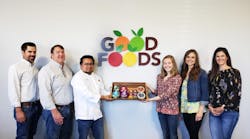Pictured above, Good Foods’ R&D team (left to right):
Joe Schaber, Stephen Babington, Gilberto Villalba, Elisabeth Weir, Katie Schmits, Joyce Longfield.
Good Foods is a company based as much on a technology as a product line or market.
Kurt Penn, founder and CEO, committed to high-pressure processing (HPP) from day one, which enables the company to make products that are gently processed with no preservatives but an extended shelf life. “Day one” was 2007 in Chicago, and his initial products were hummus and salsa.
Although guacamole was becoming hugely popular in the U.S., it was a difficult and delicate product to process. But guacamole and other avocado-based products are great candidates for HPP as the process retains flavor, texture, color and nutrients that would not hold up well under thermal treatment. HPP also provides food safety and extended shelf life without the use of preservatives. So Penn began making guacamole in 2012.
In the eight years since, his company has grown into several categories -- dairy and non-dairy dips, salad dressings, protein salads, cold-pressed juices -- but always using HPP as a key part of the process. And in most cases, those are plant-based products – a good category to be in right now. Most products are non-GMO.
“We have really deep expertise in HPP,” says Katie Schmits, director of innovation. “Every product is done with HPP; it’s the cornerstone of our business and ensures food safety, and it enables us to use the freshest ingredients and retain the flavor, texture, color and nutritional value of the ingredients.
“Our R&D team uses high-pressure processing as a way to master taste, texture, technical aptitude and operational prowess.” As a result, however, all products need to be refrigerated.
This is the second of our R&D Teams of the Year profiles. Del Monte’s team appeared last month as well as on our July 23 Podcast and Mary’s Gone Crackers will be featured next month. All three won the popular vote – in company sizes large, medium and small -- in our May web-based poll, in which 776 of our readers and website visitors voted. The medium-sized category was a close race – Good Foods edged out Daiya and Deep Indian Kitchen.
Schmits has been with the company three years, and every product she’s seen in that time has been made with HPP. Good Foods has machines from both JBT Avure and Hiperbaric, and it’s a founding member of the Cold Pressure Council, which promotes understanding of the technology.
The company moved in 2013 from its 10,000-sq.-ft. original home in Chicago to a 140,000-sq.-ft. building in Pleasant Prairie, Wis. That’s where you find the six-person innovation team, people with food science and culinary backgrounds. They have a large, culinary kitchen with benchtop equipment and lab, plus access to the company’s HPP machine. Pilot runs are done in the adjoining plant. There’s also a plant in Mexico near the source of the avocados, which makes only avocado-based products.
The team meets at least weekly, although for this intimate a group, impromptu meetings occur more often. Close ties are maintained with marketing, and quality assurance and operations teams are right there, too. Marketing has a big influence on product development; customers (retailers and foodservice) also help. Agencies are employed to track and analyze trends.
While the bulk of products are branded, Good Foods also does quite a bit of foodservice and private labeling.
Good Foods has added people with deep experience in packaging, a critical component for HPP and also important as the company launches many products in single-serve packages.
“When we develop a product, we always ask what value HPP adds. We want to make sure HPP provides some added value or a point of differentiation,” Schmits says. Some products and categories do not benefit from HPP, so the company will kill a project if there isn’t enough differentiation or value-add for a higher price.
For “protein salads” – branded cranberry almond chicken salad chicken salad and egg salad and tuna salad for private label and foodservice – shelf life would be 5-10 days without preservatives. HPP extends the freshness three to four times that, without preservatives.
Everyone on the team had a hand in developing the line of dips.
Good Foods has grown fast, and R&D is integral to the continued growth of the company. “We launch 20-30 new SKUs every year,” Schmits says. Although some of those are truly novel products and sometimes in new categories, a significant amount of R&D time is spent on extensions to product lines that have proven to be successful.
The entire length of the R&D pipeline is 2-3 years, she says, although most products can go from concept to shelf in 8-9 months.
The product line she’s most proud of are plant-based dips. “That’s a product line we worked hard on. We wanted these dips to be sought-after by everyone, not just those following plant-based diets, so we focused on making sure they tasted really good for a variety of consumer groups. I think the flavor profiles we came up with and the formula approach really delivered. The packaging, the graphics and the marketing support all came together as well.”
Good Foods offers five plant-based dips: queso, buffalo, cilantro, tzatziki and avocado pesto. Dairy-based dips are feta cucumber, creamy ranch and avocado salsa. All the dips are gluten-free and have no added sugar. Just about to launch are spicy queso blanco and spinach artichoke dips.
Salad dressings, another recent focus, also come in plant-based and dairy-based varieties. Avocado goddess, Asian ginger and harvest apple vinaigrette are examples of the former; avocado ranch, classic caesar and blue cheese are the latter.
“Avocado is so big right now we try to use it as often as possible. It’s delicious, healthy, has good fat and there are so many things you can do with it beyond guacamole.” Good Foods launched an avocado mash in 2018; just avocado, lemon juice, pepper and sea salt. As the packaging says, “Try it with toast, salad, eggs … Use it in place of mayonnaise, butter, sour cream.”
Guac remains a key part of the portfolio, and Good Foods does it three main ways: chunky, southwest and spicy, although each comes in several sizes of packaging, including some in single-serve.
“Right now we are exploring opportunities in beverages and other plant-based spaces,” says Schmits. The company already makes some cold-pressed juices under private label and for foodservice, but Good Foods is considering launching some under its own brand. Also in the works is a caramelized French onion plant-based dip, with the goal to launch by the end of the year.
She says the pandemic has slowed product development just a bit. Instead of tasting products piecemeal, “we have mega cutting days in the office when we taste 30 or 40 products. It’s also driven us to connect even more with consumers via social media and direct-to-consumer efforts.” The company plans to launch an e-commerce program any day now.
“Our product development team is small but we work so well together,” Schmits says. “We all have varied backgrounds and skills, but we share a vision of providing simple, wholesome foods that taste great. We’re always learning from each other.”


